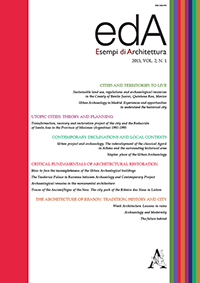Estratto da
ESEMPI DI ARCHITETTURA
International Journal of Architecture and Engineering
Naples: place of the Urban Archaeology
ESEMPI DI ARCHITETTURA
International Journal of Architecture and Engineering
Naples: place of the Urban Archaeology

This essay describes a number of projects and some possible areas of research on Naples’ sites where the presence of ancient remains from the Classical age is highly relevant and unique to the European scene: on account of their number and their intimate relationship and mingling with the urban dynamics. Firstly, this text addresses three subjects, from a theoretical point of view; the first being the relationship between the two disciplines of architecture and archaeology; the second investigates a possible definition of urban archaeology; the third concerns specifically Naples and its most ancient part as a laboratory for experimentation through projects. After this premise, two projects are explained: they are Master degree theses on areas located in the historical centre of Naples where there are archaeological ruins. Although the projects produce different results, they are bounded together by the same common lines of research and theoretical reflections. First of all, both projects are based on the conviction that archaeology in the urban context should participate in the dynamics of the living city. The archaeological remains are very often not able to fulfil the function of mere contemplation in these urban contexts, because of their size and location; therefore they must be made visible for those who walk in the city in their everyday life. Only in this way is it possible to give back to the ruins the function and sense of monuments, related to the Latin and Greek etymology of the word, rammemorare (remembrance). Another common point is that, even if we attribute the highest educational and documentary value to the ruins, the projects present themselves openly contemporary. Finally, in terms of architectural solutions, both projects work on synthetic constructions but where the different ‘parts’ are clearly visible. Moreover, the technical forms transfigure themselves into expressive forms, also coherent with the represented theme.
| pagine: | 59-70 |
| DOI: | 10.4399/97888548858686 |
| data pubblicazione: | Luglio 2015 |
| editore: | Aracne |








